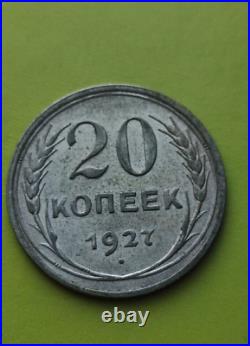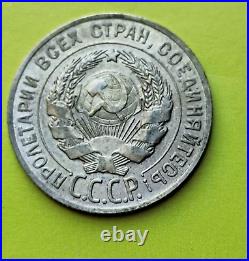


1927 Soviet Union USSR vintage 20 kopek silver coin. The Soviet Union during the Cold War. The Soviet Union, officially the Union of Soviet Socialist Republics[s] (USSR), was a transcontinental country that spanned much of Eurasia from 1922 to 1991. A flagship communist state, it was nominally a federal union of fifteen national republics;[u] in practice, both its government and its economy were highly centralized until its final years. It was a one-party state governed by the Communist Party of the Soviet Union, with the city of Moscow serving as its capital as well as that of its largest and most populous republic: the Russian SFSR. Other major cities included Leningrad (Russian SFSR), Kiev (Ukrainian SSR), Minsk (Byelorussian SSR), Tashkent (Uzbek SSR), Alma-Ata (Kazakh SSR), and Novosibirsk (Russian SFSR). It was the largest country in the world, covering over 22,402,200 square kilometres (8,649,500 sq mi) and spanning eleven time zones. The country’s roots lay in the October Revolution of 1917, which saw the Bolsheviks overthrow the Russian Provisional Government that formed earlier that year following the February Revolution and the abdication of Tsar Nicholas II, marking the end of the Russian Empire. The new government, led by Vladimir Lenin, established the Russian Socialist Federative Soviet Republic (RSFSR), the world’s first constitutionally guaranteed socialist state. [v] Persisting internal tensions escalated into the brutal Russian Civil War. As the war progressed in the Bolsheviks’ favor, the RSFSR began to incorporate land conquered from the war into nominally independent states, which were unified into the Soviet Union in December 1922. Russian Civil War in the European part of Russia. Following Lenin’s death in 1924, Joseph Stalin came to power. The forced labour camp system of the Gulag was also expanded in this period. Stalin conducted the Great Purge to remove his actual and perceived opponents. After the outbreak of World War II, Germany invaded the Soviet Union. The combined Soviet civilian and military casualty count-estimated to be around 20 million people-accounted for the majority of losses of Allied forces. In the aftermath of World War II, the territory occupied by the Red Army formed various Soviet satellite states. The beginning of the Cold War saw the Eastern Bloc of the Soviet Union confront the Western Bloc of the United States, with the latter grouping becoming largely united in 1949 under NATO and the former grouping becoming largely united in 1955 under the Warsaw Pact. There was no direct military confrontation between the two organizations; instead, the conflict was fought on an ideological basis and through proxy wars. Both NATO and the Warsaw Pact led to the expansion of military forces and their integration into the respective blocs. The Warsaw Pact’s largest military engagement was the Warsaw Pact invasion of Czechoslovakia, its own member state, in August 1968 (with the participation of all pact nations except Albania and Romania), which, in part, resulted in Albania withdrawing from the pact less than one month later. Following Stalin’s death in 1953, a period known as de-Stalinization occurred under the leadership of Nikita Khrushchev. The Soviets took an early lead in the Space Race with the first artificial satellite, the first human spaceflight, and the first probe to land on another planet (Venus). In the 1970s, there was a brief détente in the Soviet Union’s relationship with the United States, but tensions emerged again following the Soviet invasion of Afghanistan in 1979. In the mid-1980s, the last Soviet leader, Mikhail Gorbachev, sought to reform the country through his policies of glasnost and perestroika. In 1989, during the closing stages of the Cold War, various countries of the Warsaw Pact overthrew their Marxist-Leninist regimes, which was accompanied by the outbreak of strong nationalist and separatist movements across the entire Soviet Union. In 1991, Gorbachev initiated a national referendum-boycotted by the Soviet republics of Lithuania, Latvia, Estonia, Armenia, Georgia, and Moldova-that resulted in the majority of participating citizens voting in favour of preserving the country as a renewed federation. In August 1991, hardline members of the Communist Party staged a coup d’état against Gorbachev; the attempt failed, with Boris Yeltsin playing a high-profile role in facing down the unrest, and the Communist Party was subsequently banned. The Russian Federation became the Soviet Union’s successor state, while all of the other republics emerged from the USSR’s collapse as fully independent post-Soviet states. The Soviet Union produced many significant social and technological achievements and innovations. It had the world’s second-largest economy, and the Soviet Armed Forces comprised the largest standing military in the world.

